2013 FORD SUPER DUTY weight
[x] Cancel search: weightPage 29 of 95
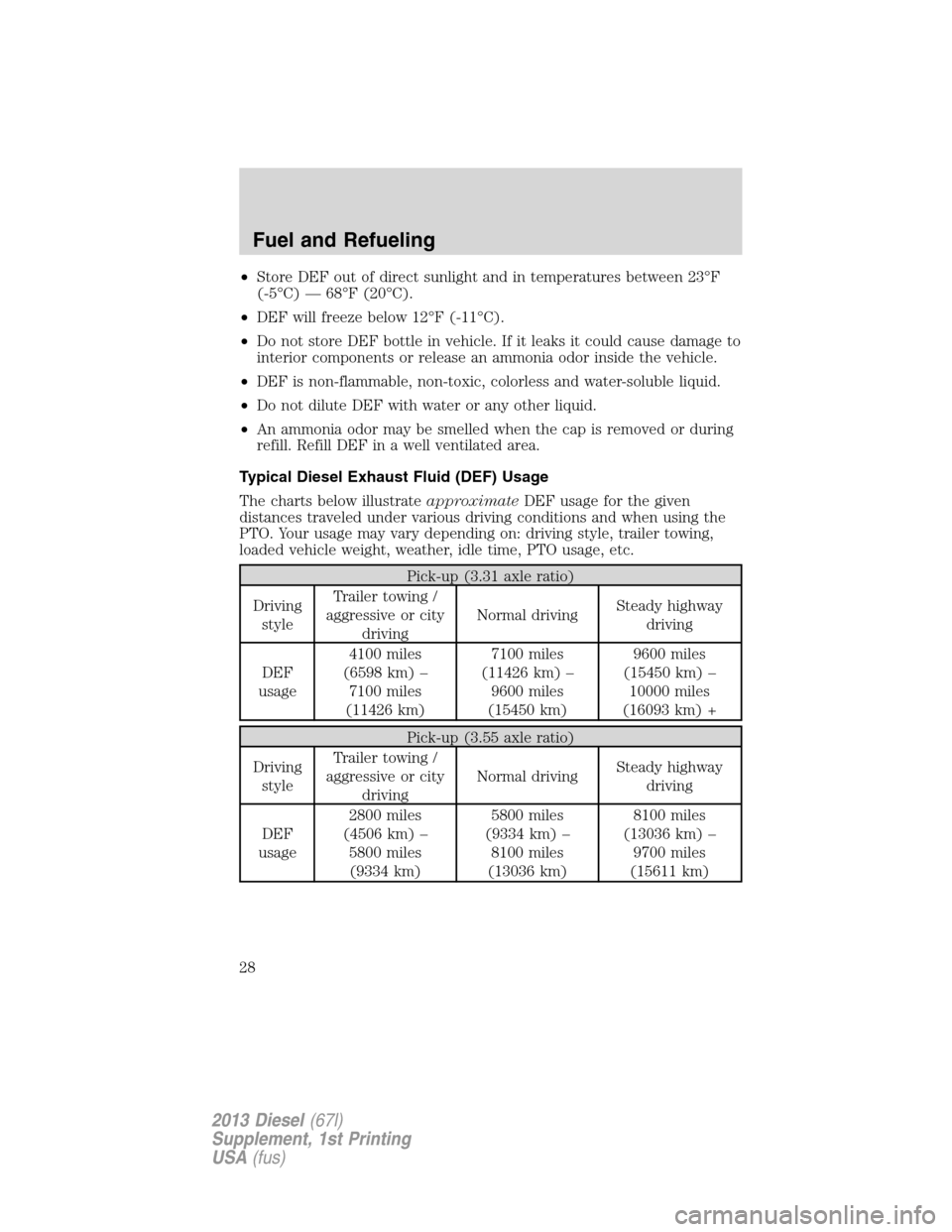
•Store DEF out of direct sunlight and in temperatures between 23°F
(-5°C) — 68°F (20°C).
•DEF will freeze below 12°F (-11°C).
•Do not store DEF bottle in vehicle. If it leaks it could cause damage to
interior components or release an ammonia odor inside the vehicle.
•DEF is non-flammable, non-toxic, colorless and water-soluble liquid.
•Do not dilute DEF with water or any other liquid.
•An ammonia odor may be smelled when the cap is removed or during
refill. Refill DEF in a well ventilated area.
Typical Diesel Exhaust Fluid (DEF) Usage
The charts below illustrateapproximateDEF usage for the given
distances traveled under various driving conditions and when using the
PTO. Your usage may vary depending on: driving style, trailer towing,
loaded vehicle weight, weather, idle time, PTO usage, etc.
Pick-up (3.31 axle ratio)
Driving
styleTrailer towing /
aggressive or city
drivingNormal drivingSteady highway
driving
DEF
usage4100 miles
(6598 km) –
7100 miles
(11426 km)7100 miles
(11426 km) –
9600 miles
(15450 km)9600 miles
(15450 km) –
10000 miles
(16093 km) +
Pick-up (3.55 axle ratio)
Driving
styleTrailer towing /
aggressive or city
drivingNormal drivingSteady highway
driving
DEF
usage2800 miles
(4506 km) –
5800 miles
(9334 km)5800 miles
(9334 km) –
8100 miles
(13036 km)8100 miles
(13036 km) –
9700 miles
(15611 km)
Fuel and Refueling
28
2013 Diesel(67l)
Supplement, 1st Printing
USA(fus)
Page 43 of 95
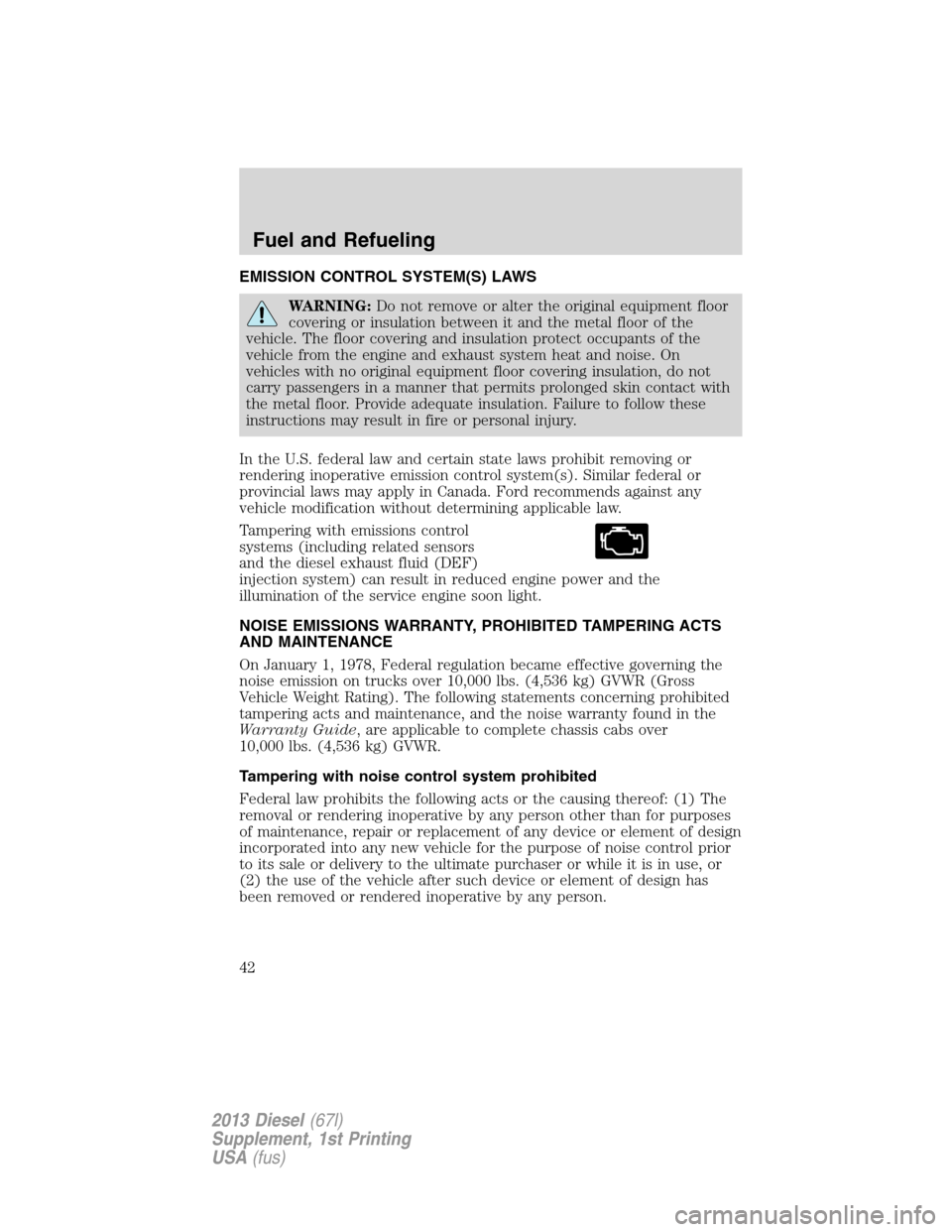
EMISSION CONTROL SYSTEM(S) LAWS
WARNING:Do not remove or alter the original equipment floor
covering or insulation between it and the metal floor of the
vehicle. The floor covering and insulation protect occupants of the
vehicle from the engine and exhaust system heat and noise. On
vehicles with no original equipment floor covering insulation, do not
carry passengers in a manner that permits prolonged skin contact with
the metal floor. Provide adequate insulation. Failure to follow these
instructions may result in fire or personal injury.
In the U.S. federal law and certain state laws prohibit removing or
rendering inoperative emission control system(s). Similar federal or
provincial laws may apply in Canada. Ford recommends against any
vehicle modification without determining applicable law.
Tampering with emissions control
systems (including related sensors
and the diesel exhaust fluid (DEF)
injection system) can result in reduced engine power and the
illumination of the service engine soon light.
NOISE EMISSIONS WARRANTY, PROHIBITED TAMPERING ACTS
AND MAINTENANCE
On January 1, 1978, Federal regulation became effective governing the
noise emission on trucks over 10,000 lbs. (4,536 kg) GVWR (Gross
Vehicle Weight Rating). The following statements concerning prohibited
tampering acts and maintenance, and the noise warranty found in the
Warranty Guide, are applicable to complete chassis cabs over
10,000 lbs. (4,536 kg) GVWR.
Tampering with noise control system prohibited
Federal law prohibits the following acts or the causing thereof: (1) The
removal or rendering inoperative by any person other than for purposes
of maintenance, repair or replacement of any device or element of design
incorporated into any new vehicle for the purpose of noise control prior
to its sale or delivery to the ultimate purchaser or while it is in use, or
(2) the use of the vehicle after such device or element of design has
been removed or rendered inoperative by any person.
Fuel and Refueling
42
2013 Diesel(67l)
Supplement, 1st Printing
USA(fus)
Page 53 of 95
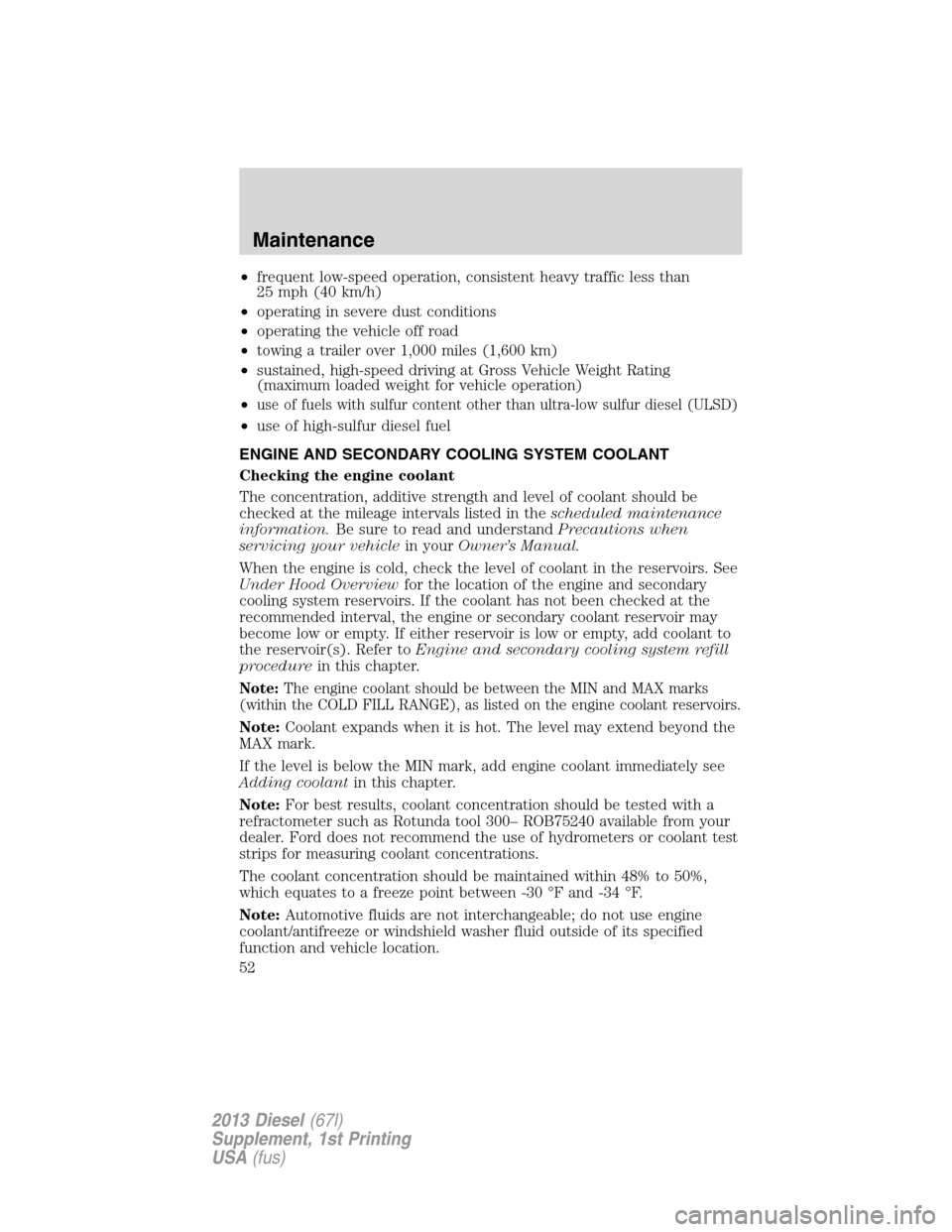
•frequent low-speed operation, consistent heavy traffic less than
25 mph (40 km/h)
•operating in severe dust conditions
•operating the vehicle off road
•towing a trailer over 1,000 miles (1,600 km)
•sustained, high-speed driving at Gross Vehicle Weight Rating
(maximum loaded weight for vehicle operation)
•
use of fuels with sulfur content other than ultra-low sulfur diesel (ULSD)
•use of high-sulfur diesel fuel
ENGINE AND SECONDARY COOLING SYSTEM COOLANT
Checking the engine coolant
The concentration, additive strength and level of coolant should be
checked at the mileage intervals listed in thescheduled maintenance
information.Be sure to read and understandPrecautions when
servicing your vehiclein yourOwner’s Manual.
When the engine is cold, check the level of coolant in the reservoirs. See
Under Hood Overviewfor the location of the engine and secondary
cooling system reservoirs. If the coolant has not been checked at the
recommended interval, the engine or secondary coolant reservoir may
become low or empty. If either reservoir is low or empty, add coolant to
the reservoir(s). Refer toEngine and secondary cooling system refill
procedurein this chapter.
Note:The engine coolant should be between the MIN and MAX marks
(within the COLD FILL RANGE), as listed on the engine coolant reservoirs.
Note:Coolant expands when it is hot. The level may extend beyond the
MAX mark.
If the level is below the MIN mark, add engine coolant immediately see
Adding coolantin this chapter.
Note:For best results, coolant concentration should be tested with a
refractometer such as Rotunda tool 300– ROB75240 available from your
dealer. Ford does not recommend the use of hydrometers or coolant test
strips for measuring coolant concentrations.
The coolant concentration should be maintained within 48% to 50%,
which equates to a freeze point between -30 °F and -34 °F.
Note:Automotive fluids are not interchangeable; do not use engine
coolant/antifreeze or windshield washer fluid outside of its specified
function and vehicle location.
Maintenance
52
2013 Diesel(67l)
Supplement, 1st Printing
USA(fus)
Page 84 of 95
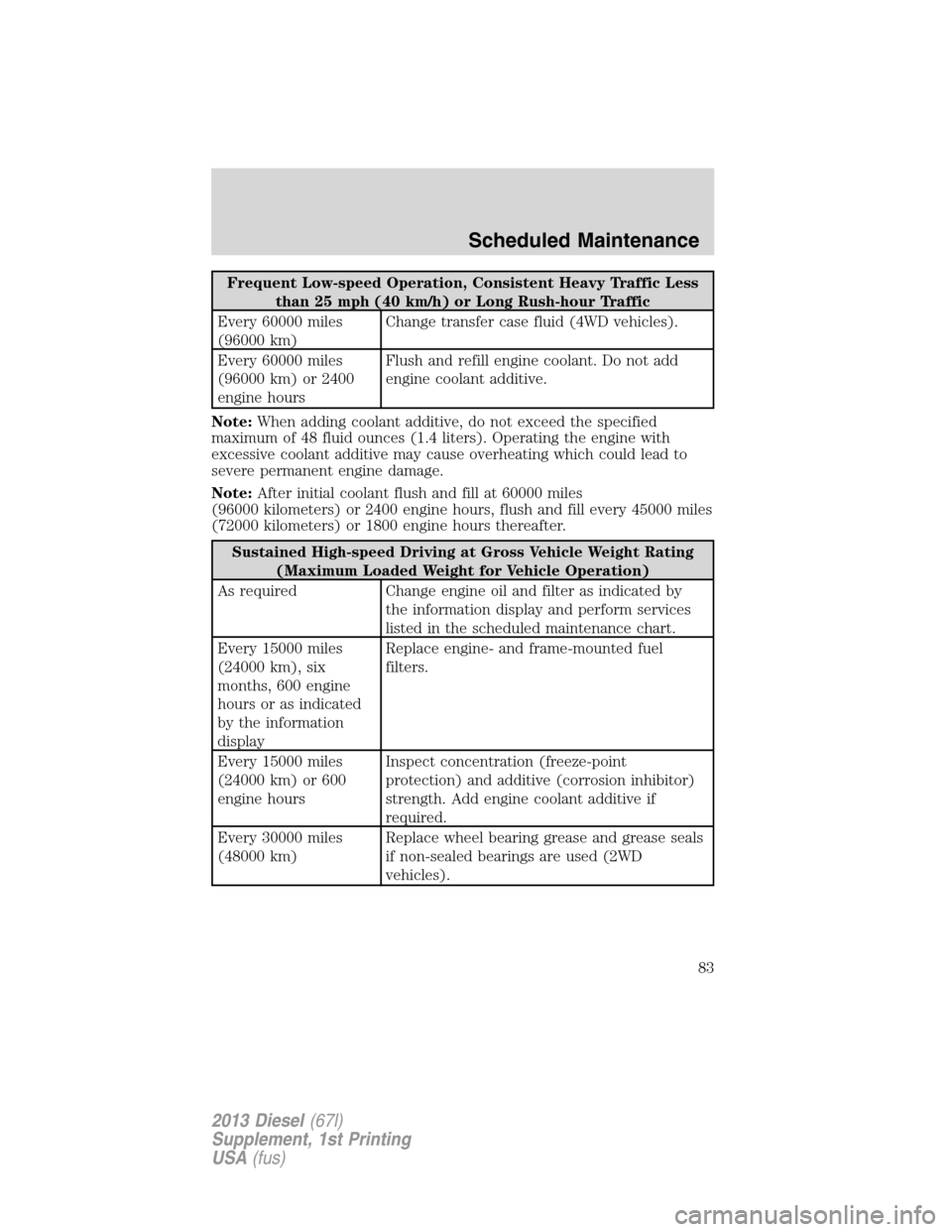
Frequent Low-speed Operation, Consistent Heavy Traffic Less
than 25 mph (40 km/h) or Long Rush-hour Traffic
Every 60000 miles
(96000 km)Change transfer case fluid (4WD vehicles).
Every 60000 miles
(96000 km) or 2400
engine hoursFlush and refill engine coolant. Do not add
engine coolant additive.
Note:When adding coolant additive, do not exceed the specified
maximum of 48 fluid ounces (1.4 liters). Operating the engine with
excessive coolant additive may cause overheating which could lead to
severe permanent engine damage.
Note:After initial coolant flush and fill at 60000 miles
(96000 kilometers) or 2400 engine hours, flush and fill every 45000 miles
(72000 kilometers) or 1800 engine hours thereafter.
Sustained High-speed Driving at Gross Vehicle Weight Rating
(Maximum Loaded Weight for Vehicle Operation)
As required Change engine oil and filter as indicated by
the information display and perform services
listed in the scheduled maintenance chart.
Every 15000 miles
(24000 km), six
months, 600 engine
hours or as indicated
by the information
displayReplace engine- and frame-mounted fuel
filters.
Every 15000 miles
(24000 km) or 600
engine hoursInspect concentration (freeze-point
protection) and additive (corrosion inhibitor)
strength. Add engine coolant additive if
required.
Every 30000 miles
(48000 km)Replace wheel bearing grease and grease seals
if non-sealed bearings are used (2WD
vehicles).
Scheduled Maintenance
83
2013 Diesel(67l)
Supplement, 1st Printing
USA(fus)
Page 85 of 95
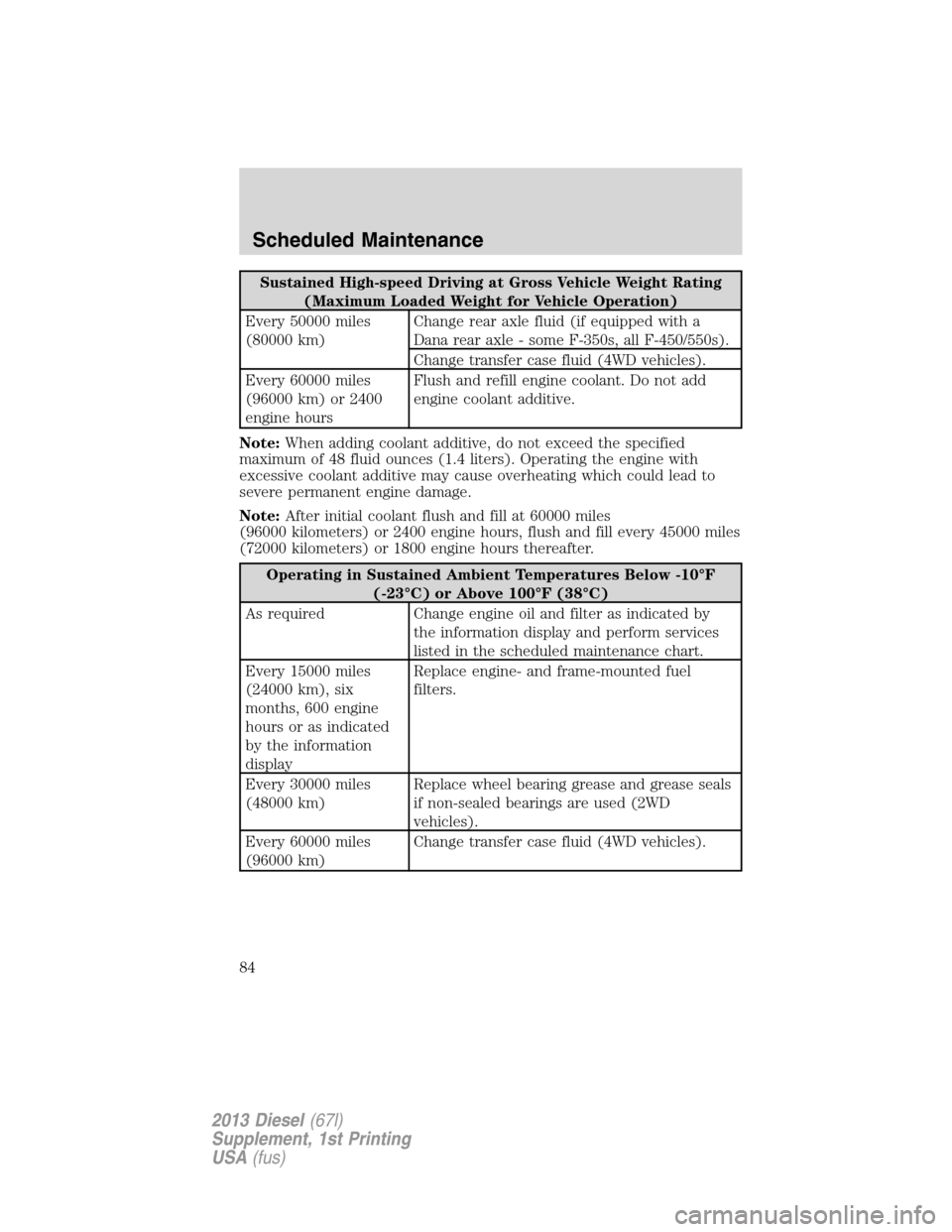
Sustained High-speed Driving at Gross Vehicle Weight Rating
(Maximum Loaded Weight for Vehicle Operation)
Every 50000 miles
(80000 km)Change rear axle fluid (if equipped with a
Dana rear axle - some F-350s, all F-450/550s).
Change transfer case fluid (4WD vehicles).
Every 60000 miles
(96000 km) or 2400
engine hoursFlush and refill engine coolant. Do not add
engine coolant additive.
Note:When adding coolant additive, do not exceed the specified
maximum of 48 fluid ounces (1.4 liters). Operating the engine with
excessive coolant additive may cause overheating which could lead to
severe permanent engine damage.
Note:After initial coolant flush and fill at 60000 miles
(96000 kilometers) or 2400 engine hours, flush and fill every 45000 miles
(72000 kilometers) or 1800 engine hours thereafter.
Operating in Sustained Ambient Temperatures Below -10°F
(-23°C) or Above 100°F (38°C)
As required Change engine oil and filter as indicated by
the information display and perform services
listed in the scheduled maintenance chart.
Every 15000 miles
(24000 km), six
months, 600 engine
hours or as indicated
by the information
displayReplace engine- and frame-mounted fuel
filters.
Every 30000 miles
(48000 km)Replace wheel bearing grease and grease seals
if non-sealed bearings are used (2WD
vehicles).
Every 60000 miles
(96000 km)Change transfer case fluid (4WD vehicles).
Scheduled Maintenance
84
2013 Diesel(67l)
Supplement, 1st Printing
USA(fus)
Page 92 of 95
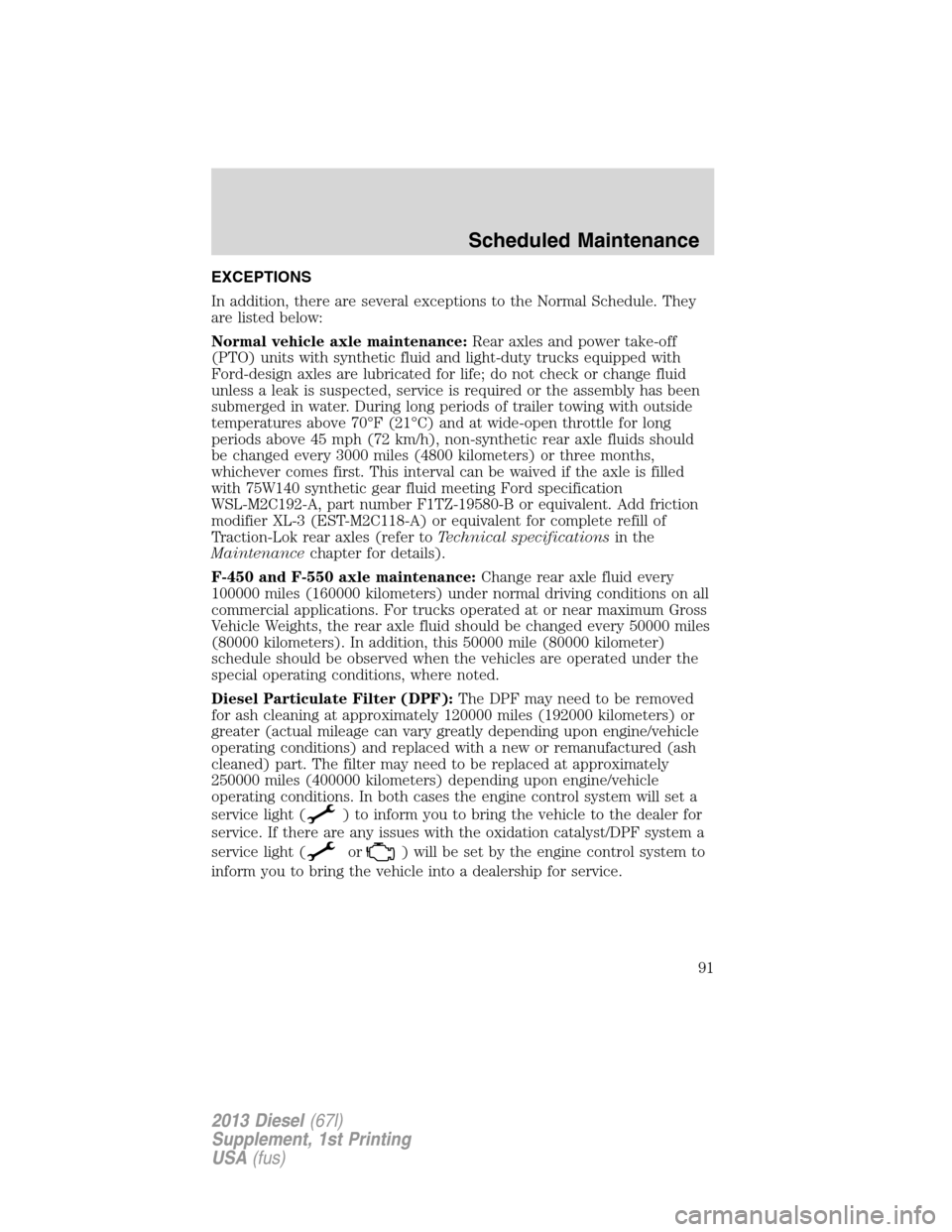
EXCEPTIONS
In addition, there are several exceptions to the Normal Schedule. They
are listed below:
Normal vehicle axle maintenance:Rear axles and power take-off
(PTO) units with synthetic fluid and light-duty trucks equipped with
Ford-design axles are lubricated for life; do not check or change fluid
unless a leak is suspected, service is required or the assembly has been
submerged in water. During long periods of trailer towing with outside
temperatures above 70°F (21°C) and at wide-open throttle for long
periods above 45 mph (72 km/h), non-synthetic rear axle fluids should
be changed every 3000 miles (4800 kilometers) or three months,
whichever comes first. This interval can be waived if the axle is filled
with 75W140 synthetic gear fluid meeting Ford specification
WSL-M2C192-A, part number F1TZ-19580-B or equivalent. Add friction
modifier XL-3 (EST-M2C118-A) or equivalent for complete refill of
Traction-Lok rear axles (refer toTechnical specificationsin the
Maintenancechapter for details).
F-450 and F-550 axle maintenance:Change rear axle fluid every
100000 miles (160000 kilometers) under normal driving conditions on all
commercial applications. For trucks operated at or near maximum Gross
Vehicle Weights, the rear axle fluid should be changed every 50000 miles
(80000 kilometers). In addition, this 50000 mile (80000 kilometer)
schedule should be observed when the vehicles are operated under the
special operating conditions, where noted.
Diesel Particulate Filter (DPF):The DPF may need to be removed
for ash cleaning at approximately 120000 miles (192000 kilometers) or
greater (actual mileage can vary greatly depending upon engine/vehicle
operating conditions) and replaced with a new or remanufactured (ash
cleaned) part. The filter may need to be replaced at approximately
250000 miles (400000 kilometers) depending upon engine/vehicle
operating conditions. In both cases the engine control system will set a
service light (
) to inform you to bring the vehicle to the dealer for
service. If there are any issues with the oxidation catalyst/DPF system a
service light (
or) will be set by the engine control system to
inform you to bring the vehicle into a dealership for service.
Scheduled Maintenance
91
2013 Diesel(67l)
Supplement, 1st Printing
USA(fus)